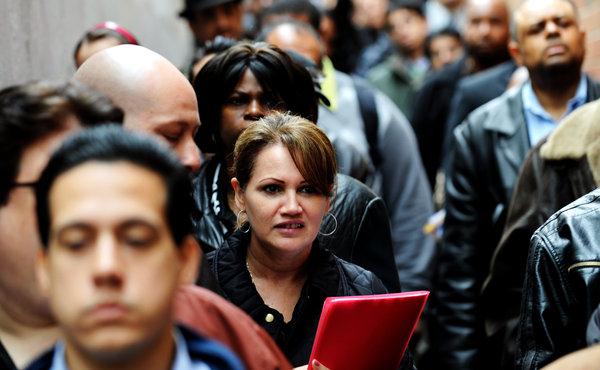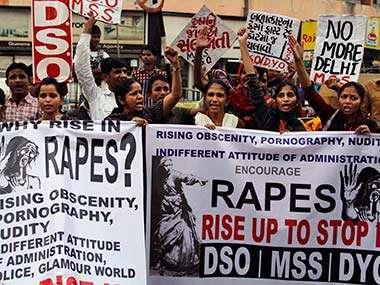May 4, 2012
The United States had another month of disappointing job growth in April.
The nation’s employers produced a net gain of 115,000 positions, after adding 154,000 in March, the Labor Department said Friday. April’s job growth was less than economists had been predicting.

May 4, 2012
The United States had another month of disappointing job growth in April.
The nation’s employers produced a net gain of 115,000 positions, after adding 154,000 in March, the Labor Department said Friday. April’s job growth was less than economists had been predicting.

Job seekers at an employment fair this week in Queens. Economists say recent job growth is not significant enough to recover the losses from the recession and its aftermath.
Mitt Romney, the presumptive Republican presidential nominee, immediately seized on the numbers, and blamed the lackluster report on President Obama’s policies. “We should be seeing numbers in the 500,000 jobs created per month,” he said. “This is way, way, way off from what should happen in a normal recovery.”
The White House accentuated the positive in the report, while acknowledging that it fell short of what was needed.
“Today’s employment report provides further evidence that the economy is continuing to heal from the worst economic downturn since the Great Depression,” said Alan B. Krueger, chairman of the Council of Economic Advisers, “but much more remains to be done to repair the damage caused by the financial crisis and the deep recession.”
The recent trajectory in the jobs numbers has not worked in the president’s favor.
“We had a run of great numbers earlier in the year, and then we get a clear softening in the last couple of months,” said Ian Shepherdson, chief United States economist at High Frequency Economics.
The slowdown, he said, could possibly be explained by unusually warm winter weather, which encouraged more companies to hire earlier in the year than they usually do. Higher gasoline prices may have played a role, too. “If it’s the gas price effect, it ought to reverse, since wholesale gas prices dropped sharply over the last few weeks,” Mr. Shepherdson said.
Analysts are also hopeful that April’s numbers will eventually be revised upward once the Labor Department receives more information from the companies it surveys. The last few months of data have already been reissued to show that job growth was stronger than first estimated.
“We have to reserve judgment until we get the final revisions on these numbers,” said John Ryding, chief economist at RDQ Economics. “I’m not trying to be Pollyannaish, but there is enough in this report to suggest that the economy isn’t necessarily slowing.”
American workers appear somewhat less optimistic.
The unemployment rate, which is based on a separate survey of American households, ticked down to 8.1 percent in April, from 8.2 percent. That may sound like good news, but the decline was not because more unemployed workers were hired; it was entirely because 342,000 workers dropped out of the labor force.
The share of working-age Americans who are in the labor force, meaning they are either working or actively looking for a job, is now at its lowest level since 1981 — when far fewer women were doing paid work. The share of men taking part in the labor force fell in April to 70 percent, the lowest figure since the Labor Department began collecting these data in 1948.
The decline in labor force participation is partly because baby boomers are hitting retirement age. But economists thought the wave of retirements would at least be offset by the number of workers rejoining the labor force as the economy improved.
“There were a lot of younger people who had gone back to school to get more education and training, and we thought we’d see more of them joining the work force now,” said Andrew Tilton, a senior economist at Goldman Sachs. Instead, the number of young people in the labor force fell. “May, June and July — the months when people are typically coming out of schooling — will be the big test.”
Friday’s report contained other discouraging news; the average workweek, for example, remained unchanged at 34.5 hours. A lengthening of the workweek might have suggested that employers were on the verge of hiring more employees, since they were already working their existing staff longer.
Government job losses, which totaled 15,000 in April, continued to weigh on the economy, tugging down job growth as local governments grapple with strained budgets. Private companies added 130,000 jobs, with professional and business services, retail trade, and health care doing the most hiring.
Such job growth is not nearly fast enough to recover the losses from the Great Recession and its aftermath. Today the United States economy is producing even more goods and services than it did when the recession officially began in December 2007, but with about five million fewer workers.
Because employers have learned how to produce more with fewer workers, there is also debate about what exactly “healthy” employment would look like in the current economy, and whether it still makes sense to use the pre-financial-crisis economy as a benchmark for what the employment landscape should look like.
On Thursday, John Williams, president of the Federal Reserve Bank of San Francisco, suggested that the “natural” rate of unemployment might now be as high as 6.5 percent. Before the recession, economists generally believed it was around 5 percent.
Productivity fell last quarter, though, which could spell good news for the nearly 14 million idle workers sitting on the sidelines, if not necessarily for the employers trying to squeeze more profits out of their existing work forces.
Economists are once again cautiously optimistic about what the next few months may bring for the nation’s unemployed, assuming the nation avoids any hugely damaging surprises.
Job growth had picked up earlier this year, just as it had at the start at the beginning of 2010 and 2011. In both of those years severe shocks to the global economy — including the Arab Spring and Japanese tsunami last year — broke some of that momentum. Economists are concerned that over the coming months high gasoline prices, a euro zone recession, and slowing growth in emerging economies like China may similarly weigh on demand for products and services from American businesses, and on hiring by those businesses as well.
Courtesy: nytimes







































































































